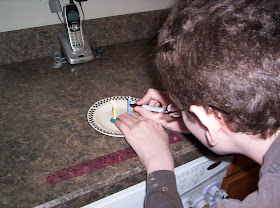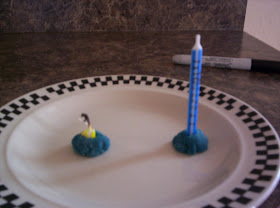 Moving forward on our time telling timeline, today, we came to the 9th century AD, and the English king, Alfred the Great's, nifty invention of the candle clock (which really should be called the candle alarm clock, or candle timer). Although, King Alfred was credited with this clock, according to FunTrivia, similar devices were also being used in China during the Sung dynasty (960-1279), though they used incense, which would be pretty cool, because you could change scents throughout the day.
Moving forward on our time telling timeline, today, we came to the 9th century AD, and the English king, Alfred the Great's, nifty invention of the candle clock (which really should be called the candle alarm clock, or candle timer). Although, King Alfred was credited with this clock, according to FunTrivia, similar devices were also being used in China during the Sung dynasty (960-1279), though they used incense, which would be pretty cool, because you could change scents throughout the day.The basis of the clock (which you might have already read about on The Fantastic Five blog), is that since candles burn at a constant rate, they can be marked to show the passage of specific time periods.
 We used two identical, except for the color, birthday candles, to make a scaled down version of the clock.
We used two identical, except for the color, birthday candles, to make a scaled down version of the clock.First, we used a couple of blobs of play dough to stand the candles up, side by side, on a plate (and yes, that is our homemade, cooked, play dough, and yes, it is still fresh, and nice).
Then we lit one of the candles, marking it's height every minute on the candle next to it. If you decide to try this at home, be careful, not to burn your finger in the process.


We discovered the birthday candles burned 1/2 centimeter per minute. On a bigger candle, you could write the amount of time passed, between each mark.

King Alfred used the candles to divide his days into periods of study, prayer, rest, and so on. Of course, he couldn't have had a fruitful rest, or prayer time, if he'd had to watch a candle out of the corner of his eye - but that's where the ingeniousness of this clock comes in. If the candle was placed over a metal plate, and a tack was stuck into the candle at the appropriate time, then as the candle burned down, and the wax melted, the tack would fall onto the plate, and alert the King, that time was up.
 We had to try this out for ourselves, too. So, we put a tack in our marked candle, at the five minute mark. We set our oven timer for five minutes, lit the candle, and busied ourselves making lunch.
We had to try this out for ourselves, too. So, we put a tack in our marked candle, at the five minute mark. We set our oven timer for five minutes, lit the candle, and busied ourselves making lunch.When we heard the tack hit our plate, we glanced at the oven timer, where there were two seconds left. We didn't think a two second error was bad, and it had worked just like clockwork!

It's great to be a homeschooler.
This is probably one of the most interesting ideas I have seen! Great research, and I love how precise your kids were with the experiment!
ReplyDeleteWe did this too (though we didn't do as much "experimenting" as you all..)! Good old King Alfred- even if he was ions behind other civilizations...
ReplyDeleteI just came across your blog for the first time and the experiment looks neat.
ReplyDeleteP.S. Thanks for the link up! YOU ROCK!!!
ReplyDeleteWe're going to have to try this! Great idea!
ReplyDeleteSo, an experiment to add to this. See if it still keeps accurate time when you're outside or somewhere there's a slight draft. I've heard it will change the burn rate.
ReplyDeleteSo cool! I am too tired to really take this in right now... will try to remember to revisit this!! ;)
ReplyDeleteJust Jenn~
@Wonder Mum
ReplyDeleteKing Alfred was NOT behind other civilizations. The article makes this plain. The article correctly states that he was Ninth Century (i.e. the 800s), and that the Sung dynasty ruled between 960-1279. King Alfred was born in 849 and died on 26 October 899.